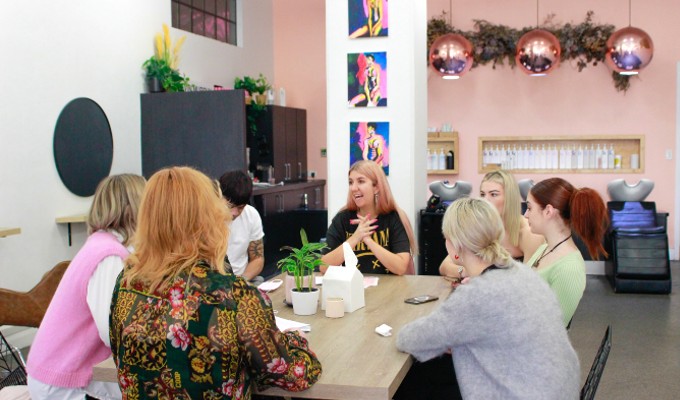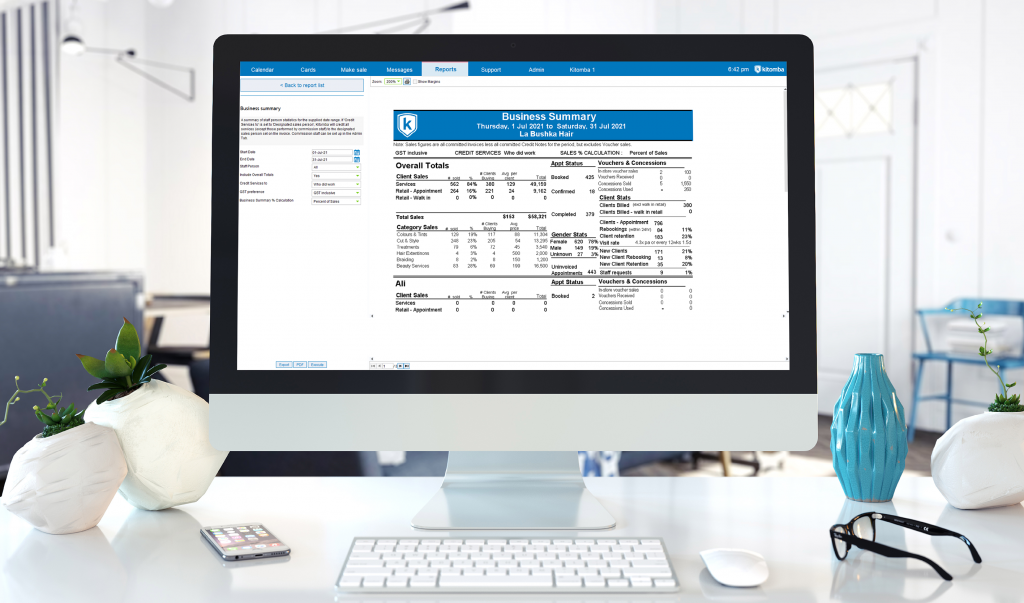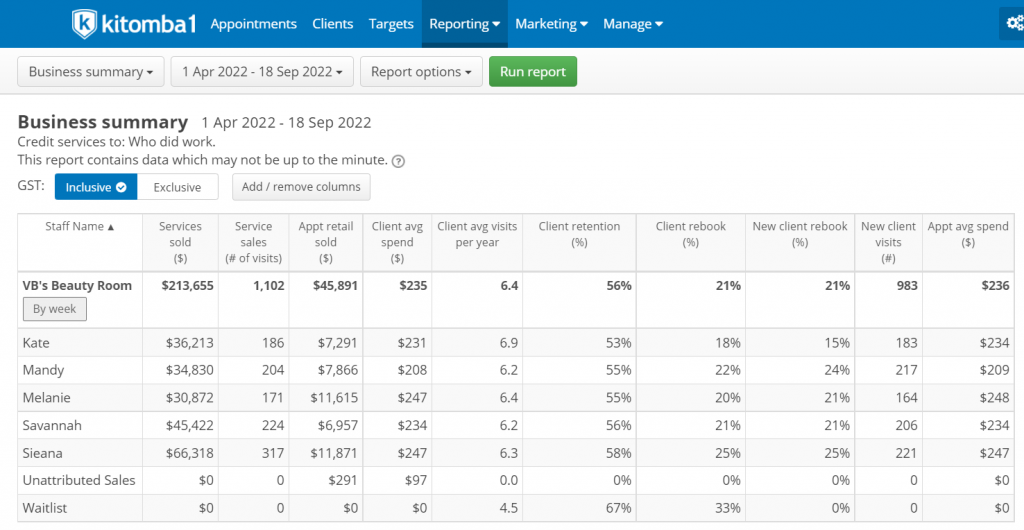Setting targets both for your salon team individually and your business as a whole can be a great way to motivate your team to strive for great results. What can make these targets perform even better in your salon, spa or clinic is the introduction of incentives to drive your team towards further success.
Here we expand on not only why you should be incentivising your salon team targets, but also how best to structure these incentives, and how your salon and spa software can streamline the system and automate calculations for you.
Why should you incentivise your salon targets?
Because it motivates your team to succeed! Introducing incentives for when targets are reached will not only increase motivation to succeed for your salon team as whole, but will also show your team you value their hard work enough to reward their achievements.
Having something tangible, or real to work towards with their targets may also give your salon staff a sense of autonomy. When managed through a salon or spa management software where they can continuously see their targets and how they’re tracking towards reaching them in real time it can provide a great sense of self-management.
For example in Kitomba 1, the Targets dashboard tells the story of their day or week and how they’re tracking towards meeting their targets, so they can see in real-time what more needs to be achieved in order to reach their goals.
Having set targets and incentives to strive for, combined with consistent rewards for reaching them, will increase employee loyalty and job satisfaction. This can help with employee retention, because when staff are consistently engaged and involved with the business they are less likely to be looking elsewhere for work. Using incentives to reward hard work and success is also a great draw when it comes to attracting new employees. Even those salon staff who aren’t necessarily incentivised by money, are usually incentivised by winning!
All these benefits for your salon staff will have a knock-on effect on your salon clientele, and therefore overall client experience, as your team members go above and beyond to meet their goals, and exceed expectations.
For more tips on team targets, read: How to introduce targets to your team for rapid growth.
How to incentivise salon targets
Now that we know why incentivising targets is important, let’s cover how to go about actually doing this.
Since no salon is the same, nor is every staff member motivated the same way, we’ll cover the key things to think about when incentivising your salon targets, but ultimately how you decide to run your incentive programme should be personalised to your salon and your team – there’s no cooker cutter approach to staff management!
Step 1: Find out what motivates your team
One of the most important factors should be finding out what motivates your team. It might be that the team doesn’t place much value on financial compensation, so take the time to find out what will inspire or stimulate them.
Perhaps they value work-life balance, in which case a paid day off would be ideal, or is it that they gel really well as a team, so a group reward may be more motivating? It could even be that some of your salon staff are genuinely driven by success, in which case any incentive will be an added bonus for them.
Step 2: Ensure the reward matches the target type
Your incentives should match the targets they’re set for. Individual incentives will work well for certain targets, however if you’re looking to improve something such as your rebooking rate, perhaps think about setting a goal for the business as a whole, with the incentive being a team reward.
You could even set a friendly competition between staff members to see who can get the highest rate. Remember to make this a fair competition, as part time staff will have lower monetary figures than full time employees, or longer serving team members.
It’s important to note incentives don’t have to be a regular occurrence, a long term goal can be just as effective, as can a one-off target incentive. Think about what targets are important to your business, and when. You may want to think about incentivising retail sales during notoriously slower months in your salon such as January or February to increase revenue.
Step 3: Choose your reward structure
Bonuses
Bonuses can come in many shapes and forms, again there are many different ways to motivate people and you or your salon manager will know what works best for both your individual team members, and for the business as a whole.
A cash bonus would be well received by most salon staff, however consider a voucher, some product, or even a lunch or free weeks worth of coffee for the team member who hits their targets. You could even make it a bonus for any salon staff who meet all of their weekly or monthly bonuses!
Bonuses as incentives to reach targets don’t necessarily need to be a weekly occurrence – you could build this up over a few weeks, or a month.
Awards
Don’t underestimate the power of an award! Even something simple such as implementing an employee of the month scheme can work for extra motivation for your salon team. Or consider something more intricate such as a paid day off – for employees that value work-life balance, have a family, or work long hours this may be the best form of compensation to give them that extra push. Be sure to factor in this extra day off to the staff members targets when calculating targets for the next period.
Experiences
A great way to reward your team for reaching business targets is to offer an experience such as an activity day out for the whole team to enjoy when they hit a certain target, or taking the team out for lunch. Working towards team targets can be hard to calculate, especially if you have staff with differing skill levels, so a target like improving your rebooking rate could be a good goal to use this type of incentive for.
Commission
Many salons use commission as a general term of employment for salon staff. Commissions are set up to compensate employees for a percentage of services or retail sold, usually once the total hits a certain threshold, commissions are paid on amounts above this. You can however also use this commission structure for incentivising salon staff to reach certain targets above and beyond their agreed pay format.
How to structure your commissions
What you pay commission on should reflect what targets you’ve set for your salon team, and also what areas of concern you’re focusing on the most. The most common metrics to pay commissions on are retail sales, service sales and appointment retail sales. If you’re using these as targets for your salon team to reach for, then commissions based reward may work well. Note that commissions should generally be individual targets, not set as whole business targets.
How to pay out your staff commissions
So, how much commission should you pay, and what should you base this on? This will differ between salons, and is very much up to you as the salon owner or manager. Industry averages can vary quite a lot between different types of salons, the size of your salon, price range of your retail products and services, and structures of your payroll.
For example, Nadia Howard from Bedlam Hair Design and Bliss Day Spa based her commissions rates on the point where her salon started to make profit. For her business it worked out at three times their wages (minus GST). For example, when a staff member at her salon had made weekly sales equivalent to three times their weekly wage, they started earning commission.
Nadia said “once they make three times their wages minus GST, that’s when you start making a profit in your business. So that’s when they start making some money, you’re making a profit and they get a portion of it. It makes them feel they’re running their business inside of yours. It keeps the team happy. It gets them excited.”
This may of course be different in your salon, and the rate of commission you decide as an incentive, or even what you decide to pay commission on is completely up to you and how you’ve decided to structure your incentives. It may even be that commission based incentives aren’t right for your business or your team.
Summing up incentive types
Different rewards can work differently for different staff, so take the time to figure out what motivates your team members and build bonuses or rewards around these.
It might even be that some of your team members want the chance to upskill or retrain in certain areas so you motivate them to reach a specific goal by paying for them to attend the course. This of course helps you as your team has expanded their knowledge, as well as increasing job satisfaction which we know helps businesses grow – especially in the hair and beauty industry where trust and overall client experience are important factors for your clients.
How your salon software can help
Use Kitomba to automatically track targets
Use your salon and spa software to its full advantage! With Kitomba Targets, targets can be easily tracked by staff anywhere, anytime. Having the capacity to see these targets remotely is great for salon managers and owners to monitor overall targets as well as individual salon team targets.
With Kitomba you also have the ability to select the right security settings to limit the access of each staff member in the system so they only see their own targets, or whichever targets you choose for them to see.
Use the Scoreboard function in Kitomba to predict where your salon is sitting in regards to reaching targets, and whether you’re on track to meet these targets. The Scoreboard picks up on future bookings and also uses past data to predict where you will be so you, and your salon team can see exactly how much you have to accomplish to reach targets for the week or month.
How to use Kitomba to calculate incentives
Kitomba can also be helpful for calculating staff commissions or rewards. Run the payroll report in collaboration with the timesheet feature (which you would have approved) to see full hours worked, as well as total services sold, retail appointment and walk-in retail sold. This report is especially useful if you’re running incentives over a set period of time, and need to know figures for exact dates.
You could also use the Staff Utilisation report for hours allocated, this shows the staff downtime (as a percentage as well as a total), client time, scheduled time, and booked appointment value. This report can also be helpful to monitor the adjustment of targets, or to see where your salon staff can upsell.
If you’re wanting to monitor metrics outside of these, Kitomba’s Business Summary report is a fully customisable report which shows, amongst other things, total sales by number of appointments or dollar value, services sold, retail sold, average spend and sales per hour. These figures are all broken down by individual staff members to make it easy to allocate rewards.
See more about why our Business Summary Report is a favourite amongst our Kitomba customers.
Learn tips for how to motivate your team to the best of their abilities in our staff management guide for salons, spas and clinics.
See more about our Kitomba Targets feature here, or setting up Targets in Kitomba with our step-by-step support guides. Or if you’re not yet a Kitomba customer, request a free demo of our salon and spa software here to see Targets in action.
Read next:
- How to introduce targets to your team for rapid growth
- Staff management guide for salons, spas and clinics
- Motivate your team for success
Feature image: MANE Salon, Wellington, New Zealand. Read more about their story here.









